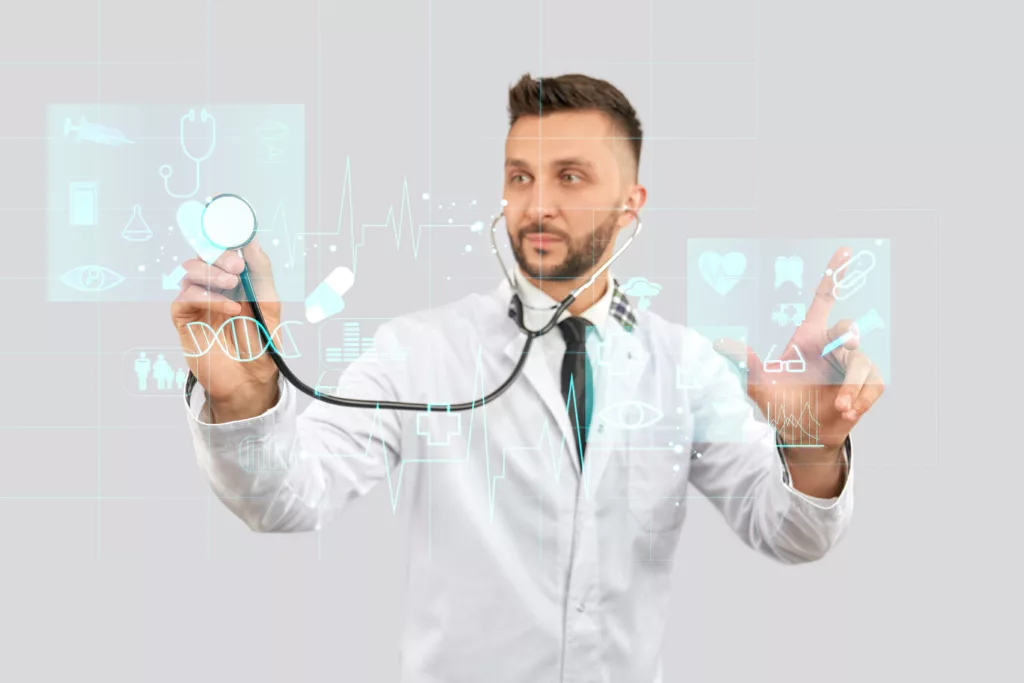
Many businesses have accepted the realities of the information age – digital transformation. After all, it plays a big part in providing customers with value. Moreover, it aids in corporate expansion and competitive advantage. Thereby, many investors are also interested in health tech startups when it comes to providing startup funding.
This also applies to the healthcare industry…
While technological developments raise the bar for quality across businesses, technology in healthcare facilities expands the scope of medical operations. Hospitals have switched to digital since the COVID-19 pandemic to guarantee patient safety while managing an ever-growing patient load.
Digital transformation in the healthcare sector typically concentrates on applying data to enhance clinical decision-making. But digital transformation in healthcare goes much beyond that; it includes applying Artificial Intelligence (AI) to improve disease detection in radiology, dermatology, gastrointestinal, and pathology, as well as machine learning for personalized treatment. These are but a few instances!
As a result, the health tech market is expected to rise to a value of $1069.13 billion by 2032. This estimate suggests that the CAGR would increase by 18.30% between 2023 and 2032 (Shuliak, 2023). Many investors are providing startup funding to groundbreaking companies in health tech.
Let us go deeper into the digital transformation trends influencing the healthcare sector!

Top 5 Health Tech Trends
#1 Generative AI in Healthcare
Numerous of these developments will involve AI, but over the course of the next year, generative AI in particular will have a significant impact. It will simplify implementation, facilitate result interpretation, and produce tailored recommendations for additional disruptive AI applications. In situations where there isn’t enough pertinent real-world data or where patient privacy is compromised, it will produce synthetic data that can be utilized to train medical AI systems. Additionally, it may generate virtual assistants and chatbots to support patients at every turn.
Reports state that this technology’s improvements could bring about corporate intelligence, freeing up clinical resources from administrative duties and allowing medical practitioners to concentrate on higher-value work. However, a strong digital core, deliberate human resource investments, and data preparedness are necessary for successful integration.
These algorithms can be trained on pre-existing datasets by utilizing generative models to produce synthetic medical pictures. When working with sparse real-world data, this is helpful. Additionally, generative AI can aid in the reduction of noise and artifacts in medical images, resulting in imaging that is more accurate and transparent.
#2 Multimodal Large Language Models (M-LLMs)
Text, image, audio, and video inputs can all be processed and interpreted simultaneously by a multimodal system. Medical AIs currently in use can only process a single kind of data, such as text or X-ray pictures.
Due to these advancements, a healthcare expert listens to the patient, reviews their medical records, examines radiological pictures, and interprets test results to diagnose and treat them. This is well beyond what any AI can do at the moment.
One way to compare the two is to compare the differences between a pentathlete and a runner. While a pentathlete needs to be proficient in several disciplines to be successful, a runner specializes in just one. The frontrunner at the moment is the unimodal Large Language Models (LLMs).
#3 Evidence-based Digital Therapeutics
Through the use of software and/or other digital health technologies, Digital Therapeutics (DTx) provides evidence-based, clinically supported solutions to manage and/or enhance medical disorders.
Usually, smartphone apps are used to deliver these solutions, making them accessible to a wide audience. Thereby, innovations like these apps are gaining the attention of investors when it comes to gaining startup funds.
Without a doubt, digital treatments and drugs work well together. Even though DTx has certain benefits, it functions best when combined with conventional treatments. When combined, they can produce amazing outcomes like lower readmission rates and better chronic illness management.
Similar to the decrease in cardiovascular events brought about by digital treatments, a study conducted by the Mayo Clinic and Healarium revealed a 40% decrease in patients’ three-month rehospitalizations and ER visits following AMI. Additionally, 4.0 kg of weight loss and a 10.8-millimeter drop in systolic blood pressure were reported in this study’s patient population.
In terms of the market, this segment is also growing in importance: the DTx market was estimated to be worth USD 5.53 billion in 2022 and is projected to increase to USD 28.66 billion by 2030.
#4 Photoplethysmography (PPG)
Blood pressure (BP) checks are classic diagnostic techniques, much like blood testing. BP monitoring has come a long way since the initial trials in the 16th century. The newest gadgets may link to mobile phones, enabling patients to take and exchange readings with their physicians.
The true breakthrough is photoplethysmography (PPG), a non-invasive optical method that measures blood flow-related changes in light intensity. Since PPG sensors allow for continuous, real-time blood pressure readings rather than just one-time measures at the doctor’s office, devices can become sleeker and handier.
For instance, the lightweight Akita smart bracelet is made to track the BP all day long. Its results have even been demonstrated to be on par with those of conventional cuff-based blood pressure monitors. Other PPG-based gadgets like the BioBeat smart patch try to monitor BP without visually doing so. The sensor is put on the body as a skin patch to provide accurate, round-the-clock monitoring (Koncz, 2023).
#5 3D Printing
The use of 3D printing in healthcare is growing in significance.
It is utilized in the production of vital health-related items like casts that help repair fractures, sophisticated medical equipment, and lightweight prosthetics. These technologies can also produce specialized surgical instruments and personalized organ models. By using the patient’s medical photos, they can do procedures that are more exact and customized. A number of industry analysts predict that 3D printing will keep growing in the future.
Over the last few years, the 3D printing market in India has experienced exponential growth. The Indian 3D printing market was valued at $92.34 million in 2022, according to Financial Times research. The market is expected to increase at a compound annual growth rate (CAGR) of 20.33% until 2030.
Conclusion
Technology and innovation are being adopted by the healthcare sector at a rate never seen before. The experience of patients and providers has significantly improved in recent years due to the explosion of new technical possibilities.
And that’s only the start!
It is unknown what healthcare innovation can do when its disparate parts come together. 2024 will see a greater impact on the industry’s overall streamlining. The world may anticipate more individualized, effective, and readily available healthcare services as new technologies develop and become a part of established healthcare systems. Furthermore, many health tech-based startups in platforms like EquityMatch are coming up with various solutions to solve pain points in this sector. This has also caught the eye of investors when it comes to startup funding.


